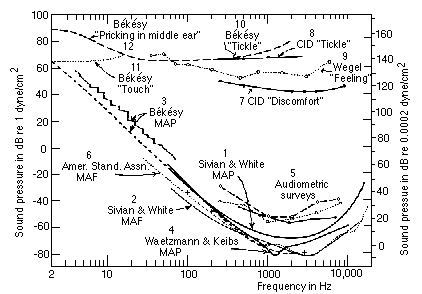|
|
The INTENSITY LEVEL of a loud sound which gives pain to the ear, usually between 115 and 140 dB (see graph). For some listeners with HYPERACUSIS these levels may be much lower.
At lower levels occur the threshold of feeling (or tickle) and the threshold of discomfort. It has been stated that this latter threshold "rises substantially with increasing habituation ... naive listeners reach a limit about 125 dB SPL and experienced listeners at 135 to 140 dB." (Edwin B. Newman, "Speech and Hearing," in American Institute of Physics Handbook, 3rd edition, p. 3-155.) Most audiologists agree however that no unprotected ear should ever be exposed to 135 dB sound.
See: ACOUSTIC TRAUMA, DAMAGE-RISK CRITERIA, DYNAMIC RANGE, SOUND INTENSITY. Compare: THRESHOLD OF HEARING, VU METER.

Determination of the threshold of audibility and the threshold of feeling. Curves 1 to 6 represent attempts to determine the absolute threshold of hearing at various frequencies by the authors listed. MAP = minimum audible pressure at the eardrum; MAF = minimum audible pressure in a free sound field, measured at the place where the listener's head had been. Curves 7 to 12 represent attempts to determine the upper boundary of the auditory realm, beyond which sounds are too intense for comfort, and give rise to nonauditory sensations of tickle and pain. From: Licklider, Handbook of Experimental Psychology, S.S. Stevens, ed., 1951, p. 995, used by permission.
home